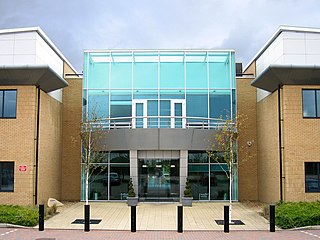Related Research Articles

Intel Corporation is an American multinational corporation and technology company headquartered in Santa Clara, California, in Silicon Valley. It is the world's largest and highest valued semiconductor chip manufacturer based on revenue, and is the inventor of the x86 series of microprocessors, the processors found in most personal computers (PCs). Intel ranked No. 46 in the 2018 Fortune 500 list of the largest United States corporations by total revenue. Intel is incorporated in Delaware.

An integrated circuit or monolithic integrated circuit is a set of electronic circuits on one small flat piece of semiconductor material that is normally silicon. The integration of large numbers of tiny MOS transistors into a small chip results in circuits that are orders of magnitude smaller, faster, and less expensive than those constructed of discrete electronic components. The IC's mass production capability, reliability, and building-block approach to circuit design has ensured the rapid adoption of standardized ICs in place of designs using discrete transistors. ICs are now used in virtually all electronic equipment and have revolutionized the world of electronics. Computers, mobile phones, and other digital home appliances are now inextricable parts of the structure of modern societies, made possible by the small size and low cost of ICs.

Potato chips, or crisps, are thin slices of potato that have been either deep fried or baked until crunchy. They are commonly served as a snack, side dish, or appetizer. The basic chips are cooked and salted; additional varieties are manufactured using various flavorings and ingredients including herbs, spices, cheeses, other natural flavors, artificial flavors, and additives. Potato chips form a large part of the snack food and convenience food market in Western countries. The global potato chip market generated total revenue of US$16.49 billion in 2005. This accounted for 35.5% of the total savory snacks market in that year.

Fish and chips is a hot dish consisting of fried fish in batter served with chips. The dish originated in England and is an example of culinary fusion, as its two main ingredients were introduced by immigrants. Fish and chips is a common take-away food in the United Kingdom and numerous other countries, particularly in English-speaking and Commonwealth nations.

Flash memory is an electronic (solid-state) non-volatile computer memory storage medium that can be electrically erased and reprogrammed. The two main types of flash memory are named after the NAND and NOR logic gates. The individual flash memory cells, consisting of floating-gate MOSFETs, exhibit internal characteristics similar to those of the corresponding gates.

A system on a chip is an integrated circuit that integrates all or most components of a computer or other electronic system. These components almost always include a central processing unit (CPU), memory, input/output ports and secondary storage – all on a single substrate or microchip, the size of a coin. It must contain digital, analog, mixed-signal, and often radio frequency signal processing functions, otherwise it will only be considered as an "Application Processor". As they are integrated on a single substrate, SoCs consume much less power and take up much less area than multi-chip designs with equivalent functionality. Because of this, SoCs are very common in the mobile computing and edge computing markets. Systems-on-chip are typically fabricated using metal–oxide–semiconductor (MOS) technology, and are commonly used in embedded systems and the Internet of Things. Higher-performance SoCs are often paired with dedicated and physically separate memory and secondary storage chips, that may be layered on top of the SoC in what's known as a Package on package (PoP) configuration.

Chip 'n Dale: Rescue Rangers is an American animated adventure comedy television series produced by Disney Television Animation. Created by Tad Stones and Alan Zaslove, it featured the established Disney characters Chip 'n' Dale in a new setting. The series premiered on The Disney Channel on March 4, 1989, after a preview episode was aired on August 27, 1988. The series continued in September with a two-hour movie special, Rescue Rangers: To the Rescue, which was later broken up into five parts to air as part of the weekday run. The final episode aired on November 19, 1990.

Medium-density fibreboard (MDF) is an engineered wood product made by breaking down hardwood or softwood residuals into wood fibres, often in a defibrator, combining it with wax and a resin binder, and forming it into panels by applying high temperature and pressure. MDF is generally more dense than plywood. It is made up of separated fibres, but can be used as a building material similar in application to plywood. It is stronger, and more dense, than particle board.

The Children's Health Insurance Program (CHIP) – formerly known as the State Children's Health Insurance Program (SCHIP) – is a program administered by the United States Department of Health and Human Services that provides matching funds to states for health insurance to families with children. The program was designed to cover uninsured children in families with incomes that are modest but too high to qualify for Medicaid. The program was passed into law as part of the Balanced Budget Act of 1997, and the statutory authority for CHIP is under title XXI of the Social Security Act.

Cookie Crisp is a cereal made to recreate the taste of chocolate chip cookies. It is manufactured by General Mills in the United States and Cereal Partners in other countries. Introduced in 1977, it was originally manufactured by Ralston Purina until they sold the trademark to General Mills in 1997, who soon after changed the recipe.
The R520 is a Graphics processing unit (GPU) developed by ATI Technologies and produced by TSMC. It was the first GPU produced using a 90 nm photolithography process.

Snapdragon is a suite of system on a chip (SoC) semiconductor products for mobile devices designed and marketed by Qualcomm Technologies Inc. The Snapdragon central processing unit (CPU) uses the ARM RISC instruction set. A single SoC may include multiple CPU cores, an Adreno graphics processing unit (GPU), a Snapdragon wireless modem, a Hexagon Digital signal processor (DSP), a Qualcomm Spectra Image Signal Processor (ISP) and other software and hardware to support a smartphone's global positioning system (GPS), camera, video, audio, gesture recognition and AI acceleration. Snapdragon semiconductors are embedded in devices of various systems, including Android, Windows Phone and netbooks. They are also used in cars, wearable devices and other devices. In addition to the processors, the Snapdragon line includes modems, wi-fi chips and mobile charging products.

A Gatsby is a South African submarine sandwich typically sold as a foot-long sandwich sliced into four portions. It is a popular sandwich in the Western Cape province, with many fast food and takeaway restaurants, stores and food stands purveying them. One large sandwich may be shared among several people. The Gatsby is also sometimes mistakenly referred to by the nickname AK‑47, which is a variant of the sandwich made in Johannesburg, in part due to how it can be held in one's arm in a similar manner to the firearm. It has been described as a "filling, budget meal", a standard menu item in Cape Town corner stores, and as a significant part of the heritage and a cultural symbol of Cape Flats, where it originated.

Random-access memory is a form of computer memory that can be read and changed in any order, typically used to store working data and machine code. A random-access memory device allows data items to be read or written in almost the same amount of time irrespective of the physical location of data inside the memory. In contrast, with other direct-access data storage media such as hard disks, CD-RWs, DVD-RWs and the older magnetic tapes and drum memory, the time required to read and write data items varies significantly depending on their physical locations on the recording medium, due to mechanical limitations such as media rotation speeds and arm movement.

Arm Holdings is a British global semiconductor and software design company, now owned by the Japanese SoftBank Group and its Vision Fund. With its global headquarters in Cambridgeshire, in the United Kingdom, and its US headquarters in San Jose, California, its primary business is in the design of ARM processors (CPUs), although it also designs other chips; and software development tools under the DS-5, RealView and Keil brands, as well as systems and platforms, system-on-a-chip (SoC) infrastructure and software. As a "holding" company, it also holds shares of other companies. It is considered to be market dominant for processors in mobile phones, tablet computers and for chips in smart TVs and in total over 160 billion chips have been made for all kinds of devices based on designs from Arm. The company is one of the best-known "Silicon Fen" companies.

Intel Core is a line of mid- to high-end consumer, workstation, and enthusiast central processing units (CPU) marketed by Intel Corporation. These processors displaced the existing mid- to high-end Pentium processors of the time, moving the Pentium to the entry level, and bumping the Celeron series of processors to the low end. Identical or more capable versions of Core processors are also sold as Xeon processors for the server and workstation markets.
In semiconductor manufacturing, the International Technology Roadmap for Semiconductors defines the 7 nm process as the MOSFET technology node following the 10 nm node. It is based on FinFET technology, a type of multi-gate MOSFET technology.

A tensor processing unit (TPU) is an AI accelerator application-specific integrated circuit (ASIC) developed by Google specifically for neural network machine learning, particularly using Google's own TensorFlow software. Google began using TPUs internally in 2015, and in 2018 made them available for third party use, both as part of its cloud infrastructure and by offering a smaller version of the chip for sale.

Epyc is a brand of x86-64 microprocessors introduced in June 2017, designed and marketed by AMD based on the company's Zen microarchitecture. They are specifically targeted for the server and embedded system markets. Epyc processors share the same microarchitecture as their regular desktop-grade counterparts, but have enterprise-graded features such as higher core counts, more PCI Express lanes, support for larger amounts of RAM, and larger cache memory. It also supports multi-chip and dual-socket system configurations through the Infinity Fabric interchip interconnect.

The third-generation iPad Air is a tablet computer designed, developed, and marketed by Apple Inc. It was announced on March 18, 2019, alongside the 5th-generation iPad Mini. The device is similar appearance wise to the iPad Air 2, but features an upgraded Apple A12 Bionic chip, a slightly larger 10.5-inch Retina Display, support for Apple Pencil, Bluetooth 5.0 and faster memory (LPDDR4X).
References
- 1 2 "Newcastle Civic Centre 1". Antiques Roadshow . Series 40. Episode 14. 17 June 2018. BBC Television . Retrieved 17 June 2018.
| This art-related article is a stub. You can help Wikipedia by expanding it. |